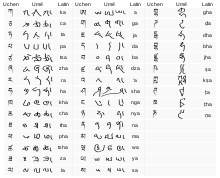Umê script
Umê (Tibetan: དབུ་མེད་, Wylie: dbu-med , IPA: [umɛ̂]; variant spellings include ume, u-me) is a semi-formal form of the Tibetan alphabet. Other Tibetan scripts include the upright book form, uchen (Tibetan: དབུ་ཅན་, Wylie: dbu-can ; IPA: [utɕɛ̃]) and the everyday, handwritten cursive, gyug yig (Tibetan: རྒྱུག་ཡིག་, Wylie: rgyug-yig ). The name ume means "headless," and is a style of the script used for both calligraphy and shorthand. A distinctive feature of umê compared to uchen is the absence of the horizontal guide line across the top of the letters. Between syllables, the tseg mark (་) often appears as a vertical stroke. There are two main kinds of umê writing:
- Drutsa (Tibetan: འབྲུ་ཚ་, Wylie: 'bru-tsa ), used for writing documents.
- Bêtsug (Tibetan: དཔེ་ཚུགས་, Wylie: dpe-tshugs ), used for writing scriptures.

There is also a block form of the Tibetan alphabet, containing a horizontal line, referred to as uchen (Tibetan: དབུ་ཅན་, Wylie: dbu-can , "with a head").